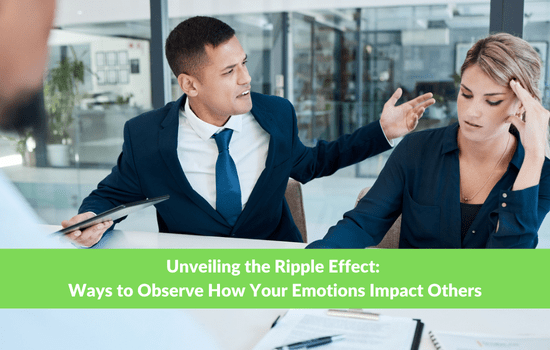Emotions are powerful and can quickly influence our mood, behaviour, and those around us, including employees and team members. We must learn to control our feelings, especially in the workplace.
The Hidden Impact of Our Emotions on Others and the Workplace

Emotions are powerful forces that shape our interactions, influence our decisions, and affect our relationships. Often, we underestimate how deeply our feelings resonate with others, creating ripples that extend far beyond our immediate awareness. In this blog, we explore the profound impact our emotions have on those around us, review seven insightful ways to observe and understand the ripple effect of your feelings and cover how emotions affect the workplace. Whether you're looking to enhance your relationships, foster a positive workplace atmosphere, or gain a deeper understanding of human connection, this guide offers valuable perspectives and practical tips.
Discovering Your Emotional Influence at Work
Have you ever noticed someone's face change as you tell a story with strong emotions? There's no doubt that our emotions have a ripple effect, influencing not only our moods but also those of the people around us. This impact is especially significant in team environments, where emotional states can shape group dynamics and productivity.
Emotions are natural and essential. However, when our emotions overpower us, they can interfere with our effectiveness and send unintended messages that affect our team members. Leaders, in particular, need to be aware of emotional contagion—the phenomenon where emotions spread from one person to another—because it can significantly impact team cohesion and morale.
Seven Ways to Observe the Ripple Effect of Your Emotions
By employing these strategies, you can become more aware of the ripple effect your emotions have on others and your environment. This awareness can help you manage your emotional expressions more effectively and create a positive impact.
- Pay Attention to Reactions
- How Others Respond: Observe how people react to your emotional expressions. Do they smile when you're happy or seem tense when you're stressed?
- Behaviour Changes: Notice if people's behaviours change around you based on your emotional state. For example, they might become more reserved if you're angry or more open if you're joyful.
- Monitor Group Dynamics
- Team Atmosphere: Observe the overall mood and energy in group settings, such as at work or social gatherings. See if your emotions influence the group's dynamics, increasing enthusiasm or causing tension.
- Conflict or Harmony: Pay attention to whether your emotions contribute to conflicts or harmony within the group.
- Track Conversations
- Tone and Content: Notice how the tone and content of conversations change based on your emotional input. Positive emotions might lead to more uplifting discussions, while negative emotions could result in criticism or complaints.
- Engagement Level: Observe whether people are more or less engaged in conversations with you depending on your emotional state.
- Reflect on Feedback
- Direct Feedback: Listen to direct feedback from others about your emotional expressions. They might comment on how your mood affects them or the environment.
- Non-Verbal Cues: Pay attention to non-verbal cues, such as body language and facial expressions, which can indicate how your emotions impact others.
- Observe Physical Environment
- Atmosphere Changes: Notice any changes in the physical environment that might correlate with your emotional state.
- Space Utilization: Pay attention to how people use the space around you. They might distance themselves when you're upset or draw closer when you're positive.
- Personal Journaling
- Daily Reflections: Keep a journal to reflect on your daily interactions and the emotions you express. Record your feelings and any noticeable changes in others' behaviours or attitudes.
- Patterns and Trends: Over time, look for patterns and trends in your journal that indicate the ripple effect of your emotions.
- Seek External Perspectives
- Third-Party Observations: Ask trusted friends, family members, or colleagues to share their observations about how your emotions influence others.
- Professional Insight: Consider seeking insights from a therapist or counsellor who can provide an objective perspective on the impact of your emotional expressions.
How Emotions Impact the Workplace
Emotions significantly impact the workplace, influencing everything from individual performance to organizational culture. Here are some ways emotions affect employees and team members:
- Motivation: Positive emotions like enthusiasm boost motivation, leading to increased productivity and higher-quality work.
- Focus: Negative emotions such as stress can impair concentration and decision-making, reducing productivity.
Team Dynamics and Collaboration
- Cohesion: Positive emotions foster team cohesion and a sense of camaraderie, while negative emotions can lead to conflicts and tension.
Creativity and Innovation
- Openness: Positive emotions encourage open-mindedness and risk-taking, essential for creativity and innovation.
- Stifling Creativity: Negative emotions can create a fear of failure, stifling creativity.
Employee Engagement and Retention
- Engagement: Positive emotions contribute to higher employee engagement and job satisfaction.
- Turnover: Persistent negative emotions can result in disengagement and higher turnover rates.
Customer Relations
- Customer Service: Employees experiencing positive emotions are more likely to provide excellent customer service.
- Negative Impact: Negative emotions can lead to poor customer interactions.
- Inspirational Leadership: Leaders who display positive emotions inspire their teams and foster a positive work environment.
- Demoralizing Impact: Leaders who frequently express negative emotions can demoralize their teams.
Organizational Culture
- Positive Culture: A workplace where positive emotions are encouraged tends to have a more positive organizational culture.
- Toxic Culture: A culture dominated by negative emotions can become toxic, leading to widespread dissatisfaction.
Stress and Well-being
- Well-being: Positive emotions promote well-being and reduce stress.
- Health Issues: Chronic negative emotions can lead to stress-related health issues.
Decision Making
- Rational Decisions: Positive emotions enhance rational decision-making and problem-solving skills.
- Impulsive Decisions: Negative emotions can lead to impulsive or biased decisions.
- Effective Communication: Positive emotions facilitate open and effective communication.
- Miscommunication: Negative emotions can lead to misunderstandings.
Understanding and managing emotions in the workplace is crucial for creating a positive, productive, and supportive environment that benefits all employees, team members, and the organization. Emotional intelligence training can significantly impact your team's development, efficiency, and overall productivity.
For a deeper dive into emotional contagion and to develop self-awareness to enhance your emotional intelligence, consider exploring our Emotional Intelligence Assessment & Coaching services. My book, The Power of Emotion, provides further insights into the power of mindfulness and emotional regulation. Marshall Connects offers Emotional Intelligence Assessments and Coaching to help you develop skills like emotional regulation to improve your life and overall productivity. Contact us today!
This article was originally published on February 24, 2018, and has been updated (July 2024).
More Motivational Reads Here »
How Emotionally Intelligent Are You?
Sign up for Linda's monthly tips to build your Emotional Intelligence and reduce Emotional Hijacking!

















